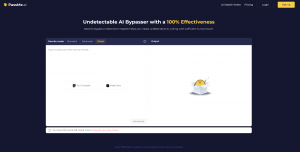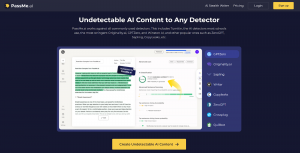In the rapidly advancing world of artificial intelligence and content creation,
the need for tools that can navigate the intricate landscape of AI detection has
become increasingly crucial. Enter PassMe.ai, a cutting-edge solution that has
garnered attention for its ability to transform AI-generated text into content
that seamlessly blends with human writing. This comprehensive review delves into
the intricacies of PassMe, exploring its features, effectiveness, and potential
applications as an undetectable AI writer and bypasser.
Redefining AI-Generated Content

PassMe presents itself as a sophisticated AI
bypasser, engineered to metamorphose machine-generated text into prose that
bears the hallmarks of human authorship. The platform boasts a state-of-the-art
language model, purportedly trained on an extensive dataset of 200 million data
points, enabling it to strip away the telltale signs of AI writing and produce
content that exudes natural, human-like qualities.
PassMe’s Core Capabilities
- AI Detection Evasion: At its heart, PassMe is designed to help users craft
content that can slip past a variety of AI detectors, including industry
stalwarts like Turnitin, Originality.ai, and GPTZero. - Plagiarism Mitigation: Beyond its primary function, PassMe also aims to
eliminate traces of plagiarism, ensuring that the reworked text stands as
original content with minimal duplication scores. - Versatile Rewriting Options: The platform offers a spectrum of rewriting
modes, including Standard, Advanced, and Ghost, allowing users to tailor the
level of transformation to their specific needs. - Linguistic Diversity: PassMe claims to support an impressive array of over
50 languages, positioning itself as a versatile tool for content creators across
various linguistic domains. - Risk-Free Exploration: Users can dip their toes into PassMe’s capabilities
with a free plan, providing an opportunity to assess its efficacy before
committing to a paid subscription.
Mechanics Behind PassMe
PassMe’s approach to creating content that evades AI detection involves a
multi-faceted process:
Erasing AI Fingerprints
The cornerstone of PassMe’s functionality lies in its ability to identify and
erase the subtle patterns that typically betray AI-generated text. By doing so,
it aims to produce content that mirrors human writing styles with remarkable
fidelity.
Preserving Semantic Integrity
While transforming the text, PassMe strives to maintain the core message and
intent of the original content. This delicate balance is crucial for ensuring
that the rewritten text remains true to its initial purpose.
Elevating Textual Fluency
The platform places a strong emphasis on enhancing the overall flow and
naturalness of the text, aiming to create content that not only bypasses AI
detection but also reads with the smooth cadence of human-authored prose.
PassMe in Action: Real-World Applications
PassMe positions itself as a versatile solution for various content creation
needs across different sectors:
Scholarly Pursuits
Students and academics may turn to PassMe to ensure their AI-assisted work
maintains an air of originality and successfully navigates through academic
integrity checks.
Digital Content Creation
Web content creators can leverage PassMe to sidestep potential penalties from
search engines that might otherwise flag AI-generated content, potentially
boosting their site’s search rankings.
Corporate Communications
Professionals might employ PassMe to refine AI-drafted correspondence and
reports, infusing them with a more natural, human touch.
Assessing PassMe’s Prowess in Bypassing AI Detectors

The efficacy of PassMe in bypassing AI detection is a pivotal aspect of its
value proposition. While the platform asserts its ability to work against all
commonly used detectors, including rigorous ones like Originality.ai and
Turnitin, the actual success rate may fluctuate based on several factors:
- Detector Sophistication: As AI detection tools continue to evolve, their
ability to identify AI-generated content may improve, potentially challenging
PassMe’s effectiveness over time. - Content Complexity: The nature and intricacy of the original text may
influence how successfully PassMe can transform it into undetectable
content. - User Configurations: The chosen rewrite mode and other user-defined
parameters could significantly impact the outcome and detectability of the final
text.
It’s worth noting that while PassMe aims for unparalleled effectiveness, the
dynamic nature of AI technology means that absolute guarantees in this field are
challenging to maintain consistently.
Navigating the Ethical Landscape
The emergence of tools like PassMe raises important ethical questions about the
nature of content creation and academic integrity. While the platform can be a
valuable asset for refining and improving AI-generated content, users should
carefully consider the following:
- Academic Honesty: In educational settings, the use of such tools may
conflict with institutional policies on academic integrity and original
work. - Transparency: Content creators should weigh the implications of presenting
AI-assisted work as entirely human-generated, especially in professional
contexts. - Quality Assurance: While PassMe can help bypass AI detection, users should
still meticulously review and edit the output to ensure it meets their quality
standards and accurately conveys their intended message.
PassMe in the Competitive Landscape
In the burgeoning market of AI bypassing tools, PassMe faces competition from
other platforms offering similar services. While a comprehensive comparison is
beyond the scope of this review, it’s worth noting that PassMe’s claims of
effectiveness and its range of features position it as a formidable contender in
this space.
Factors that may set PassMe apart include:
- The breadth and depth of its training dataset
- The sophistication of its underlying language model
- The extensive range of supported languages
- The intuitiveness of its user interface
- Its pricing structure and accessibility
Prospective users would do well to weigh these aspects against other available
tools to determine the best fit for their specific requirements.
Conclusion: PassMe’s Place in the AI Writing Ecosystem
PassMe.ai represents a significant leap forward in the realm of AI-assisted
writing, offering a sophisticated tool that aims to bridge the divide between
machine-generated content and human-like text. As an undetectable AI bypasser,
it provides a solution for those seeking to create content that can evade AI
detection while maintaining quality and originality.
However, the use of such tools comes with inherent responsibilities. Users must
carefully consider the ethical implications and ensure they are using PassMe in
a manner that aligns with their professional, academic, or personal integrity
standards.
As the landscape of AI writing and detection continues to evolve at a rapid
pace, tools like PassMe will likely play an increasingly pivotal role. They
offer a glimpse into the future of content creation, where the boundaries
between human and AI-generated text become increasingly indistinct.
Ultimately, while PassMe and similar undetectable AI writers can be powerful
allies in the content creation process, they should be used judiciously and in
tandem with human creativity and discernment. As with any tool, its true value
lies not just in its capabilities, but in how it is applied to enhance rather
than replace human skills and insights in the ever-changing world of digital
content creation.
